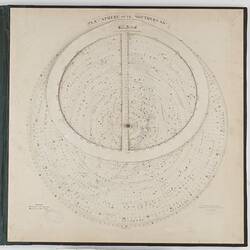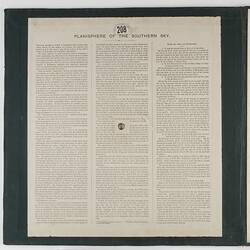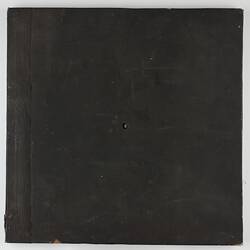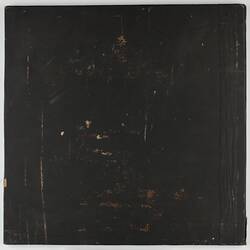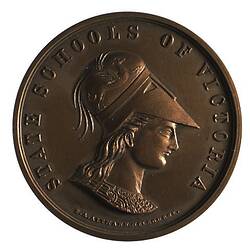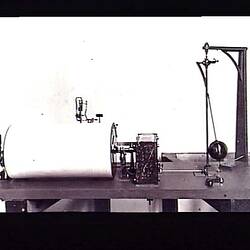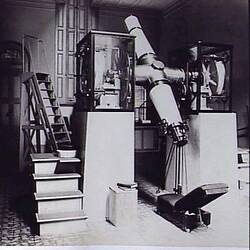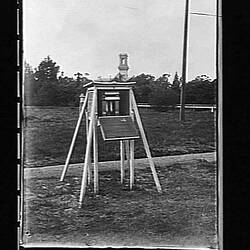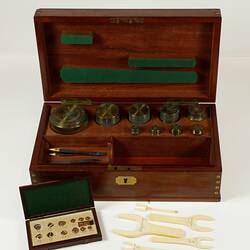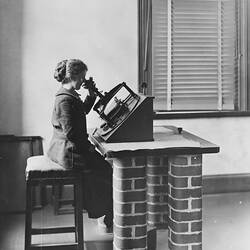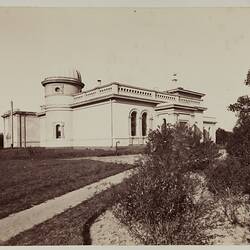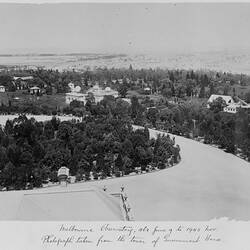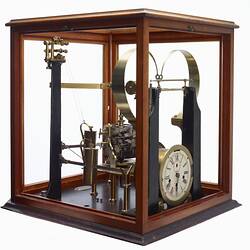Summary
'Plansphere of the Southern Sky', produced by Melbourne Observatory and published by the Victorian Government Printer, 1881.
500 copies were initially produced for public sale and quickly sold. A special edition was published by the Victorian Education Department for use in schools.
Planispheres were a common device used for popular astronomy in the 19th and 20th centuries. This planisphere was produced by the Melbourne Observatory, one of the most significant scientific enterprises undertaken in colonial Victoria. The planisphere includes an essay on astronomy.
Physical Description
This object is a black, hardbound folder. When opened it has a three column essay "Planisphere of the Southern Sky" on the left side. On the right, is a circular planisphere consisting of three layers: the base, the star chart and the horizon. "The base is the square sheet of cardboard upon which the other parts are mounted, and on it is printed a circle divided into the hours of the day as shown by an ordinary watch or clock - that is, into two sets of twelve hours, and each hour is divided into spaces of ten minutes; this is called the Hour Circle. "Attached to this by a pivot in the centre is the planisphere proper, which is a circular chart, upon which are plotted all the fixed stars down to the fifth magnitude (which are those easily seen with the naked eye) visible in Melbourne; this portion will be called the Chart. "Upon the chart, and attached by the same central pivot, is an oval-shaped ring of cardboard, with a bar across its centre, upon which divisions are marked indicating the distance in degrees from the north pole, or north polar distances. The inner edge of this ring represents the visible horizon, and the divided edge of the bar across it the meridian of the place of observation. Around the horizon are marked the principal points of the compass. The centre of the chart, through which the pivot passes, represents the south polar point of the heavens, of the south celestial pole, and from this centre lines (celestial meridians) radiate to the innermost circle at the circumference of the chart."
Significance
The Melbourne Observatory was one of the most significant scientific enterprises undertaken in colonial Victoria. The Observatory was originally established in 1853 at Williamstown, later moving to its site at the Royal Botanic Gardens. From 1869 it housed the Great Melbourne Telescope an internationally significant instrument and the last major speculum reflecting telescope ever produced. Although the Observatory was not principally a research institution it contributed to practical matters in the colony such as timekeeping, navigation and surveying. It also contributed to several astronomical projects, being ideally placed in the southern hemisphere to complement northern hemisphere observatories, and conducted a series of important longitudinal measurements in meteorology and geophysics.
Planispheres are the direct descendent of the astrolabe, a mediaeval instrument usually constructed of brass. Planispheres allow the user to see which stars will be visible at any given time of night on any day of the year. The user does this by rotating a central disc across a star map. A section cut out from the disc represents the observers horizon and allows the user to see all stars on the map below which would be above the horizon at that time. Planispheres are constructed for a particular latitude although there is a reasonable range in latitude over which they are useful.
More Information
-
Collection Names
-
Collecting Areas
-
Acquisition Information
Donation from Rotary Club of Long Island/Frankston, 20 Feb 2003
-
Publisher
Melbourne Observatory, South Yarra, Greater Melbourne, Victoria, Australia, 1881
-
Inscriptions
"PLANISPHERE OF THE SOUTHERN SKY" "Constructed at the Melbourne Observatory & Published by Authority of the Victorian Government / Will'm Slight. Engraver." Number '208'.
-
Classification
-
Category
-
Discipline
-
Type of item
-
Object Measurements
47 cm (Length), 1.1 cm (Width), 47 cm (Height)
Closed.
-
Keywords

